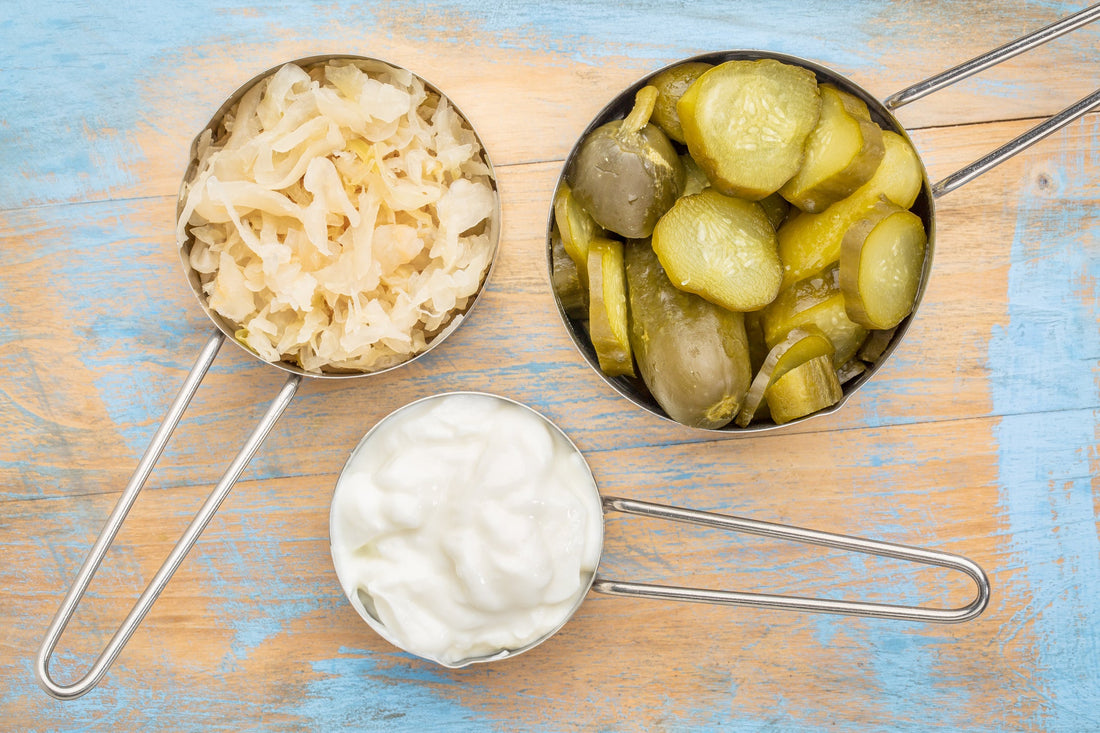Read Time: 7 min | Categories: Body Health | Gut Health
7 Best Probiotic-Rich Foods
Leigh Matthews, BA Hons, H.Dip. NT
Share this article
Probiotics are microorganisms that benefit health. Probiotic foods contain these beneficial microorganisms, helping to top up a healthy microbiome. Yogurt is probably the best-known probiotic food, but many other foods are also packed full of bacteria and yeasts that all play a role in good health.
Some of the most delicious, nutritious, and commonly available
- Sauerkraut
- Yogurt
- Kimchi
- Tempeh
- Miso
- Pickles
- Kombucha
Maybe you’re already partial to pickles and have been tempted by tempeh, but what about those other probiotic foods? Here’s a quick intro to each one and some tips on how to include them in your daily diet.
Sauerkraut
Sauerkraut is a staple in many Eastern European countries, but this sour, salty, fermented cabbage is new to many North American dinner tables. Sauerkraut is a great source of probiotics and also provides vitamin C and other nutrients to support good health.
Most store-bought sauerkraut has been pasteurized, killing all the bacteria, even the good ones. So, make sure to buy traditional sauerkraut that still contains probiotics, or create your own at home!
Sauerkraut is easy to eat, slightly crunchy, and super delicious. It goes especially well with most kinds of meat and potato dishes.
Ways to Eat Sauerkraut
| Eat with avocado toast for breakfast | 2 Tbsp |
|---|---|
| Serve with spicy or smoked sausages in a bun for breakfast or lunch | 3 Tbsp |
| Add a dollop to soup or stew for lunch | 1 – 2 Tbsp |
| Serve on the side with pierogis, baked or mashed potatoes, stews, soups, or salads |
2 Tbsp |
Yogurt
Yogurt is often a great source of live cultures,including Lactobacillus acidophilus and bifidobacteria, to support digestion and general health. Like sauerkraut, store bought yogurt may have been pasteurized, or even created without live cultures, meaning it’s important to check the label and find a product that contains probiotics.
Avoiding dairy? Don’t worry. These days, there are tons of dairy-free yogurts made with almonds, cashews, coconut, and soy, many of which contain live cultures.
If you’re making yogurt a daily staple, try to choose unsweetened probiotic yogurts, so you can avoid inadvertently increasing your sugar intake.
Ways to Eat Yogurt
| Add to granola and fruit for breakfast | 3 Tbsp |
|---|---|
| Mix with a mid-morning smoothie | 3 Tbsp |
| Swirl into soup for lunch | 1 – 2 Tbsp |
| Serve on the side with chili, baked potatoes, stew, curry, and other hot dishes |
2 Tbsp |
Miso
Miso is a staple probiotic food in Japan and is very popular in macrobiotic diets. Although miso is traditionally made from fermented soybeans, it can also be made from rice, barley, and rye.
Miso is packed with lactobacilli and bifidobacteria, meaning it is a great choice for supporting both small and large intestines. Miso is also usually quite salty, however; so you only need a little bit and will want to mix it with water or unsalted broth.
Miso can be used to make a delicious, umami-rich, low-calorie soup, or added to stews and marinades. It is also a source of B vitamins and other nutrients.
Ways to Eat Miso
| Add a little to water for savoury breakfast oatmeal | ½ Tbsp |
|---|---|
| Mix with tahini and unsalted stock or broth for a ramen noodle lunch | ½ Tbsp |
| Add to a marinade for tofu, mushrooms, veggies, or meat | 1 Tbsp |
Pickles
Pickles sometimes have their own aisle at the grocery store, and for good reason. If you haven’t discovered the world of pickles yet, you’re in for a treat. These crunchy, tangy, sometimes spicy, sometimes sour, and always delicious probiotic foods can include pickled beets, beans, cucumbers, onions, radish, ginger, asparagus, and many other veggies.
Some store-bought pickles are pasteurized, and some have added sugar or preservatives, so it’s best to avoid them. Look for pickles made with traditional methods, such as kosher pickles made using brine. You can also make your own pickles at home with certain types of cucumbers, beans, and onions specially bred for storage through pickling.
Ways to Eat Pickles
| Eat a sweet pickle, such as onion or ginger, with a breakfast sandwich | 1 Tbsp |
|---|---|
| Snack on pickled beans or asparagus with hummus or another dip mid-morning | 4–5 pickled beans/asparagus tips |
| Add sliced pickles to sandwiches for lunch or serve as a side | 1 Tbsp |
| Try pickled radish and ginger with sushi | ½ Tbsp |
Tempeh
Like miso, tempeh is also traditionally made from fermented soybeans, though it can also be made from chickpeas and other legumes. Tempeh is a fantastic source of probiotics and protein and has a deliciously nutty and mushroom-like flavour.
Ways to Eat Tempeh
| Make a tempeh breakfast Reuben | 1 slice/piece of tempeh |
|---|---|
| Marinate tempeh with oil, soy sauce, maple syrup, and liquid smoke for a piece of plant-based bacon at breakfast, lunch, or dinner | ½ block, thinly sliced and fried |
| Sauté tempeh pieces and include with ramen or noodle dishes | ½ block, cubed |
| Process with mushrooms and veggies to make a protein-packed veggie burger mix | 1–2 blocks to make 12 burgers |
| Lightly pan fry slices of tempeh and add to salads or rice bowls | ½ block, sliced and fried |
Kimchi
Consider kimchi the Asian cousin to Eastern European sauerkraut. Like sauerkraut, kimchi is primarily made with fermented cabbage, though it also typically includes vinegar, garlic, chilli peppers, and scallions, and even radishes, carrots, and other veggies.
Kimchi is typically spicy and sour and is a popular probiotic food eaten at breakfast, lunch, and dinner, especially in Korean cuisine. A great digestive aid, kimchi is also an important source of vitamins A, C, B1, and B2, and beta-carotene, calcium, and iron, especially in those winter months when fresh veggies are hard to find.
Ways to Eat Kimchi
| Mix with eggs and scramble for breakfast, or add to an omelet | ¼–1 cup kimchi (cut big pieces into smaller slices) |
|---|---|
| Straight out of the jar as a snack! | ½ cup |
| Add to rice, noodles, or soup for lunch or dinner | 2–3 Tbsp |
| Use a toothpick to make kimchi bites with larger chunks of cabbage and veggies | 1–2 Tbsp |
| Serve on the side with Korean barbeque dishes | 2 Tbsp |
| Heat up a little kimchi with oil as a side dish, or serve cold | ½ cup |
| Include in a tortilla wrap with veggies and shredded tofu, tempeh, or meat | 2 Tbsp |
| Make kimchi pancakes with scallions | ½ cup kimchi and ½ cup kimchi juice to every ½ cup flour |
| Make spicy, buttery kimchi pasta sauce | ½ cup kimchi to 1 stick of butter |
| Kimchi mac and cheese | ¼ cup added as a mid-layer |
Kombucha Tea
Kombucha is a fermented tea that contains a plethora of probiotics, thanks to the bacteria naturally present on black tea leaves. This tasty probiotic drink is easy and cheap to make at home and is a little bit tangy. It’s also a great pick-me-up as it typically contains caffeine.
Unfortunately, many store-bought kombucha drinks have a lot of added sugar, so check labels carefully or make your own stash at home.
Because kombucha contains caffeine, it’s best to drink it in the mornings and early afternoons only. You can sometimes find kombucha made with decaffeinated black tea, but this is rare. If you’re making your own kombucha at home, you can experiment with different types of tea!
To make flavoured kombucha, you can add grated ginger, fruit, and spices during the first or second (bottle) ferment. If you want to make a batch of a single flavour, the first ferment is often easier. To experiment with different flavours, and to add a little extra carbonation to the bottle, add the fruit when bottling. Bottled kombucha can usually last in the fridge for a week or more, but high fruit content can lead to bottle explosions, so beware of adding too much to a single bottle! Once you’ve established a good kombucha brewing rotation, you should always have a convenient source of probiotics on tap!
Ways to Drink Kombucha
|
In place of your morning coffee or tea |
1 glass |
|---|---|
| Added to smoothies or juice | 1 cup |
| In place of your afternoon tea or coffee | 1 glass |
| As a kombucha float! | 1 cup kombucha to 1 scoop of ice cream |
